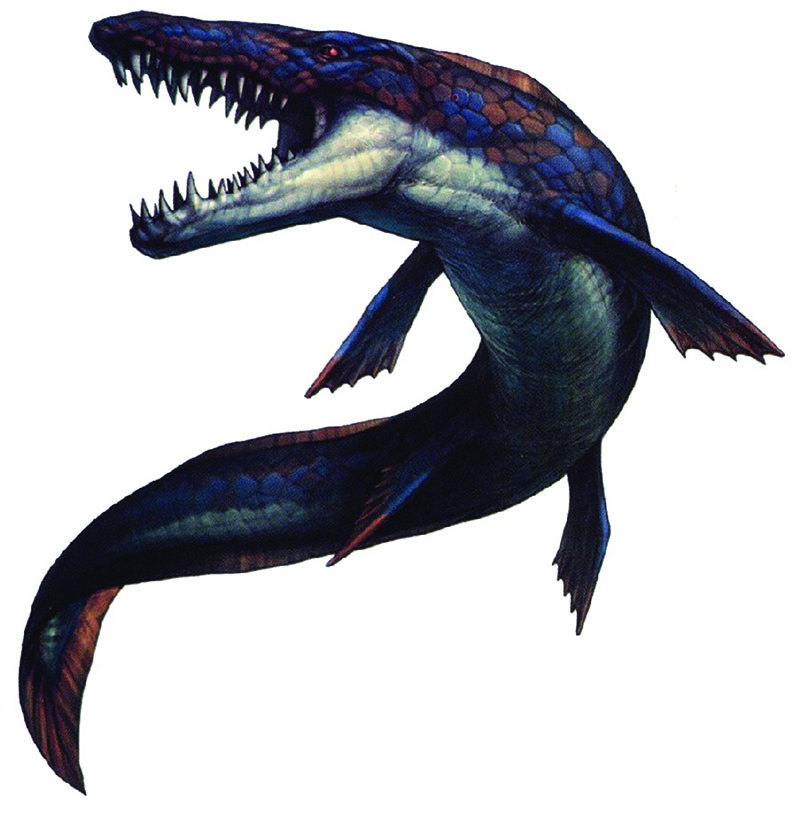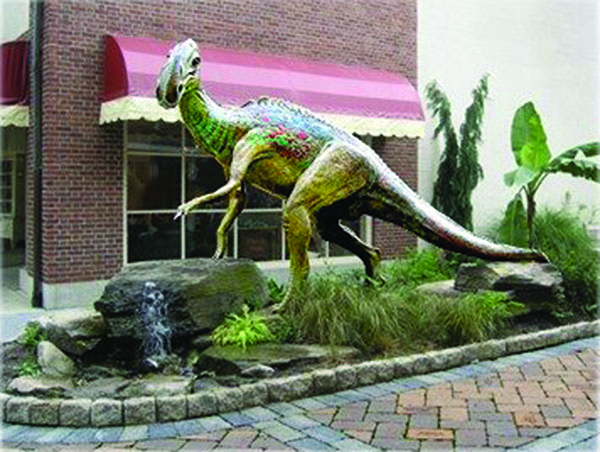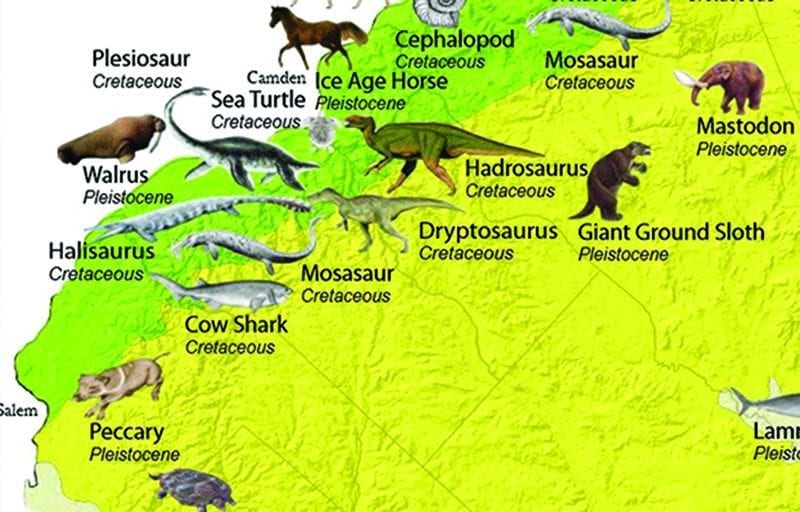By Jean Redstone
It’s the new year. Time for folks to think about past events and plan for future endeavors.
By “past” I mean anywhere from 100 million to 65 million years ago. By “future” I mean from now to a couple or so years from now.
And by “folks” I mean your community leaders and strategists. Leaders like Alice O’Blennis, chair of Swedesboro’s Economic Development Committee.
O’Blennis began looking to the prehistoric past, and more specifically, the Cretaceous past, when she learned that fossils of the mosasaur Clidastes were unearthed in the Swedesboro area sometime in the 1800s. Mosasaurs were gigantic late-Cretaceous marine lizards, at their largest, the size and weight of a whale. They preyed upon fish, turtles, sea birds, and other less gigantic water denizens.
The fossil bones unearthed were somewhere between 66 million and 75 million years old and were quite the find in the early 1800s, when the field of paleontology was nascent.
She admitted she was fascinated by the information the Economic Development Committee was given when backers of a plan to build a dinosaur trail offered a proposal that would include Swedesboro and surrounding areas where fossils had been found. The project would take advantage of the already well-known Mantua Fossil Park dig as a starting point and would spotlight the known finds of various fossils from Swedesboro and nearby municipalities.
The committee, O’Blennis said, agreed to co-ordinate with Visit South Jersey, a promotion and marketing company funded by grants from the state Department of Travel and Tourism, according to company representative Michael Snyder. He and the Swedesboro committee are working toward a unique tourism draw designed to bring people and purchases to the area. The plan requires dinosaurs.
Happily for the project and inspiration for the plans, South Jersey is literally carpeted with dinosaurs and other critters of prehistoric ages. You may be walking on their bones daily.
In fact, the very first nearly complete dinosaur fossil skeleton found in the world was dug up in Haddonfield in the mid-1800s. “Haddie”, the Hadrosaurus, a huge plant-eating creature of the Cretaceous period, now has a museum in Haddonfield dedicated to the story and the science that brought the find to the public.

But there is an even closer museum in the works in Mantua that will celebrate an on-going dinosaur dig. The Jean and Ric Edelman Fossil Park is already the site of numerous finds from digs into the sand quarry that used to support the Inversand mining company.
According to Dr. Kenneth Lacovara, renowned paleontologist at Rowan University and director of the Fossil Park, the museum and park will be a public attraction. The fossil park is currently open just one day a week, and there’s a lot of people wanting to go, possibly because any fossils you find, you can take home.
The Edelman Fossil Park is central to the venture that O’Blennis’ committee and Snyder envision. “I’ve been told they’re planning to build a $65 million museum and Visitors’ Center at Mantua’s dig site,” O’Blennis said. We want to develop a dinosaur trail similar to the Wine Trail that takes visitors from winery to winery in the (Coastal Plain) region,” she said.
South Jersey is in the Coastal Plain, having been inundated with ocean a mere several hundred million years ago.
Snyder elaborated, “The Mantua dig site would be the hub,” he explained. “Trails would spoke out from the hub to sites in nearby areas where dinosaurs have been found. You could visit the dig, the museum, then choose a trail to follow.” Or several trails, perhaps, he added.
O’Blennis said she is already reaching out to businesses and asking for input, suggestions, ideas and support. “This (plan) gives us the opportunity to kind of do what we want with it. Visit South Jersey is working with us and our businesses.”
One idea O’Blennis put forth in a recent interview was for a bronze statue. “Like the one Haddonfield has for their dinosaur. It’s just in the ‘wish for’ stage,” O’Blennis continued, “but we could put it on municipal ground, at the lake or park or some place. Sites where a (prehistoric find) were made could have a statue. Already we’re talking about a sculptor recommendation.
“We want to work with our businesses as a whole, to be a resource for us,” O’Blennis said. “It’s not just (Swedesboro). Woolwich also has a dinosaur find, other places have them.”
Lacovara, in an earlier interview, noted that the Swedesboro and nearby areas were once famous for dinosaur fossil finds, seminal events in the then fairly new field of modern paleontology. Besides Hadrosaurus, the first skeleton of a tyrannosaur species, the Dryptosaurus, was unearthed in the mid-1800s in what is now Ceres Park, Mantua. A mosasaur, Clidastes, which was a very huge marine lizard with teeth to match, was found in Swedesboro.
And that’s not all. “There have been other dinosaur finds in Barnsboro, in Mullica Hill, at Pedricktown,” Lacovara said.
South Jersey has a history as a source of dinosaur discoveries, especially during the mid-to-late 1800s and early 1900s. Lacovara identified the area in western South Jersey that roughly follows the turnpike from the Delaware Memorial bridge all the way north and east to Freehold as a rich lode of fossil remains, particularly of the Cretaceous period, which lasted from about 145 million years ago, to about 65 million years ago, when it was closed by a global extinction event. The finds include fossils of ancient fish, turtles, clams, mammals and more, besides the popular dinosaur remains.
The popularity of dinosaurs and other fascinating ancient long-dead fauna has been a draw for the fossil dig at Mantua, Lacovara said. It has attracted tourists from other states and countries and he predicted the museum and fossil dig would become a major go-to place of international tourism.
That’s just what has attracted Swedesboro’s attention. O’Blennis and Snyder said. The success of “Haddie” at Haddonfield and the waiting list of would-be fossil diggers at Mantua, prove the power of the past.
O’Blennis, who said she and the Economic Development Committee have been working toward incorporating dinosaurs into Swedesboro’s future for at least two years, is eager to continue. “I think, and I know this is early, but I think this could become international in scope,” she said.
Her enthusiasm is shared by Snyder, who said he, too, has been working with Dr. Lacovara and the Mantua dig for some time, planning and brainstorming. “Our goal over the next two years is to see the fossil park at Mantua become a major tourist spot,” he said. “Then offer trails to other places where fossils have been found.

“So far, Swedesboro is our first, and our biggest municipality to be interested, but we are approaching Harrison, Woolwich, Mantua, Haddonfield, Bellmawr, and other places,” he said. “We want to make sure that while people all around the world are visiting Mantua’s dig, they will have a reason to go elsewhere for dinosaur sites.”
And while doing that, Snyder added, the tourists might like to experience the area’s local wineries, breweries, distilleries, restaurants, stores and scenery. “We have a lot to work with here in South Jersey,” he said, with satisfaction.
“We are still putting the final proposal together and will likely approach the municipalities early next year,” Snyder predicted. “The feedback so far has been very positive, very excited. Our plan is, hopefully, to open the dinosaur trails when the museum at the Fossil Park opens.
“I see this as a positive all around,” Snyder continued. “More business for the towns means more money for the towns. They will likely do fundraising for donations for statues or other extras, but in the next two or three years these towns will see so many new faces.”
Unlike dinosaur discoveries, every one of which requiring patience and long-term perseverance, Snyder said he can’t wait. “I can’t wait for the towns to see new visitors. I can’t wait for them to see the income that comes,” he said.
While slightly less ebullient, O’Blennis said she, too, hopes to see an influx of tourists. “Well, the downside might be getting overrun with tourists,” she chuckled. “But that’s a good thing to have.”













